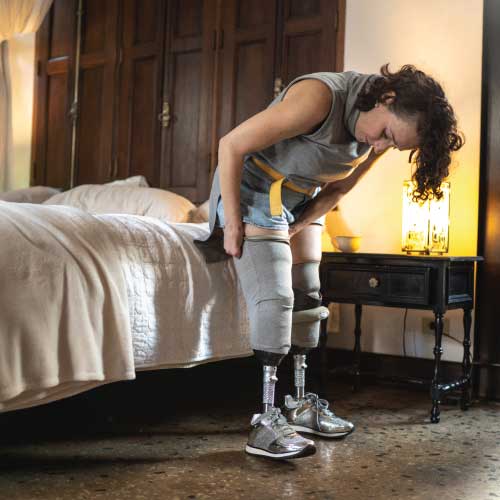3 AI Prosthetic Developments to Watch Out For
There is no shortage in prosthetic technology developments. But among the many, we have picked out three promising projects that use artificial intelligence (AI) to reshape the way prosthetic limbs are used.

Improved compatibility between prosthetic arm and residual limb
Researchers at Helsinki University Hospital and Imperial College London are exploring newer technology that enables compatibility between a prosthetic arm and a residual limb.
Although the technology seems promising, researchers have run into one problem: how to improve the connection between the muscle that gives movement commands and the prosthetic limb. As it turns out, this connection between muscle and prosthetic limb can become weak due to external factors, like sweating.
Existing prosthetic systems require adjustments and other measures from the user. This new technology will work differently because AI learns from the user and adapts to varying conditions. With this new system, the user and the system simultaneously learn from each other.
According to lead researcher and Aalto University doctoral candidate Dennis Yeung, this new prosthetic system has the potential to improve the “convenience and robustness of robotic” prosthetic limbs.
Adaptive prosthetic devices, like this one, are expensive. But the research team is committed to improving the reliability of the systems, which will reduce the financial risks for individuals and public health institutions.
How AI is changing prosthetic arm control
Researchers are currently developing prosthetic software that can distinguish a user’s intention based on the way muscles move and contract. However, the issue with this system is that users need to contract their muscles in specific patterns to generate wrist or hand movements. These patterns are typically frustrating and time-consuming because they are counterintuitive.
So, researchers led by University of Minnesota’s Anh Tuan Nguyen and Diu Khue Luu need to find a method to gauge and translate nerve signals to control the movement of a prosthetic hand, finger, or arm.
Luu, Nguyen, and colleagues have found a way to do this using an AI decoder, which learns users’ movement intentions based on the nerve signals it senses in the arm.
The results are stunning. In tests, study participants achieved the intended action 99.2% of the time. Furthermore, the subjects report that each movement feels intuitive as the AI system matches the intended motion.
The research team is refining their work to achieve fine motor control, such as applied force estimation, wrist supination (rotating the forearm into a palm-up position), and wrist extension (moving the hand up towards the forearm’s posterior). They will also work on shortening reaction time.
Testing the brain’s ability to adapt to advanced prosthetic limbs
Researchers at Limbitless Solutions have begun a first-of-its-kind four-month clinical trial to determine how the brain adapts to advanced prosthetic limbs in children born without a limb. Its goal is to improve how children control their prostheses.
According to the U.S. Centers for Disease Control and Prevention, approximately four out of 10,000 babies are born with limb differences. However, little is known about how their brains respond to the addition of a prosthetic device.
The researchers are examining how a Limbitless prosthetic device (paired with a training video game) will affect the motor control center of the brain. The clinical trial also aims to monitor changes in the brain signals sent to muscle groups that direct the prosthetic limb’s movement.
The researchers will closely monitor brain signals using advanced functional magnetic resonance imaging (fMRI) techniques before and after training and prosthetic use. The team will also use tractography, a 3D modeling technique that visualizes the nerve pathways in MRI scans. This will help researchers recognize new or better nerve pathways created from the video training game.
This study is promising because it combines video game-based training and advanced imaging methods to evaluate the engagement of the motor cortex.
Which development are you looking forward to the most?











































































